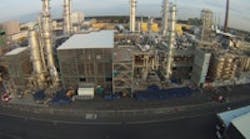When I learned officials of the Frankfurt International Airport in Germany were planning to build a new runway right next to the 40-year-old original Celanese Ticona polyoxymethylene (POM) facility, I thought, "No problem, we'll just move."
Then the situation's enormity hit. We had to build a new plant and move operations there while maintaining production of the acetal copolymers at the original facility — all while adding minimal headcount. I realized this was a rare project that only comes around once in a career, and it wouldn't be easy. It would force everyone involved to deliver more than they thought they could.
Figure 1. Ten centers on the site provided safety information, drinking water and protective equipment.
[Related: Orchestrate an Effective Safety Culture]
We continued to improve the safety programs throughout the project — especially after four recordable safety incidents in May and June 2010. While the incidents themselves weren't serious, we were on the cusp of the peak of the construction workforce, with piping, electrical and instrumentation scheduled for the next eight months, so we needed to prepare accordingly.
We learned that people typically don't deliver if they're not accountable. So, with the goal to maintain safety, we created and implemented a new cyclical work process consisting of five elements:
1. setting and meeting expectations;
2. engaging all work levels in the field;
3. reinforcing safe behaviors;
4. recognizing good safety performance; and
5. measuring safety performance.
We went through the five steps and then started over, using metrics to initiate action and set and meet expectations.
"I particularly liked the way both Ticona and their construction manager went to lengths to ensure safe working by such a multilingual workforce. Exactly as we would expect a GSK construction site to be managed," says Thorpe.
DEVELOPING THE RIGHT CULTURE
On peak staffing days, up to 1,400 people worked onsite. To some, this scenario would have been a logistical nightmare but we were used to it. Starting on day one of this project, all the main project disciplines had to collaborate to change the safety culture. The teams representing environmental health and safety, operations, procurement and contract management, as well as project and construction management kept the information flowing regarding potential hazards.
Communication was a priority. Therefore, we talked about safety at every opportunity and shared information in multiple languages and media. Early each morning, a combination of Celanese representatives, our construction contractor and its subcontractor leaders hosted a mass safety meeting and a safety task analysis for all work groups. During these meetings, which were attended by as many as 500 to 700 workers, we reviewed the day's main activities and safety issues as well as discussed feedback. Senior construction managers also hosted crew lunches to gather feedback.
When customers visited the site, they wore appropriate safety gear and were escorted at all times. "The site was kept clear with good separation of personnel and vehicles," GSK's Thorpe recalls.
We learned that we had to drive hard to achieve a high-performing safety culture. To do that, we had to engage all workers. It took creativity and perseverance to attain the level of engagement we wanted. In addition to the morning meetings, we set up ten knowledge centers (Figure 1) as onsite safety havens for each of the main construction units. The centers were convenient locations for safety information, drinking water and safety equipment, and served as central points to hold meetings. We also added pedestrian walkways in vehicle-congested areas and better fencing and handrails on scaffolds to avoid falling objects and improve visibility; we also required workers to wear safety harnesses in all elevated areas including scaffolds.
[Related: Make Safety Second Nature]
To reinforce the culture, we posted signage, posters and slogans. One of the most popular safety event guests was "Safety Johnny," our stuffed worker mascot, who constantly fell from ladders, scaffolds, stairs and pipe racks and found himself underneath moving trucks. After such incidents, we demonstrated and discussed the right way to be safe.
Another challenge was high turnover among workers during different project phases. When those specializing in civil engineering were finished, other workers such as the piping team came in and needed to be acclimated to the culture. The constant dialogue was a huge help in bringing new teams up to our standards.
Routine safety checks became commonplace. Various managers took informal safety walks throughout the day to watch for potential issues and reward safe behavior with small presents. These safety walks provided us with our main metrics and also helped us monitor progress using safety observation cards to detect and solve safety issues. We also had a monthly lottery with prizes for each month without an incident.
A POSITIVE MOVE
The unexpected could happen to anyone. We turned the unexpected into a new facility that will produce 140,000 tons of POM annually. In the process, we created an engaged safety culture and achieved a turnaround in safety performance.
We now are transferring safety tools and processes to other sites and businesses within Celanese and across the industry. Authorities responsible for supervising construction projects in Germany have requested the tools we used. IGR, the Community of Interest for Industrial Practices, which is a technical council of German chemical companies, has recognized our efforts, and the European Chemical Industry Council presented Celanese a commendation for our contractor safety practices.
Each day during the project, I reminded myself and the management team that the workers came to the site safe this morning, so let's get them home safe again tonight. It's how we should approach every construction project as well as each day's work.
KARL FRED WOERNER is European Union health and safety leader for Celanese, Dallas. E-mail him at [email protected].
